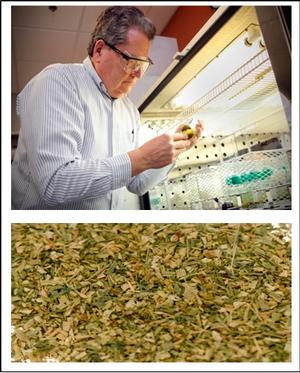Feb
15
Bioengineering Improved Switchgrass Makes More Ethanol
February 15, 2011 | Leave a Comment
A team led by Zeng Yu Wang of The Samuel Roberts Noble Foundation in Ardmore, Oklahoma and Jonathan Mielenz, a co-author and member of the Department of Energy’s BioEnergy Science Center at the Oak Ridge National Laboratory has designed a transgenic version of switchgrass that produces about one-third more ethanol by fermentation than conventional switchgrass.
That suggests bioethanol from new lines of the native perennial prairie grass could become less costly to produce. This improved plant feedstock could be able to generate more biofuel per acre, benefiting not only the transportation sector but also the growers and farming community. It’s key that the net revenue per acre for landowners and farmers of biofuel can compete with other agricultural practices.
Mielenz begins the explanation, “Recalcitrance, or a plant’s natural defenses against insects, fungus and the weather, is widely acknowledged as being the single biggest barrier to the production of biofuel and biochemicals from switchgrass and other lignocellulosic materials.” Think of recalcitrance as being tough. The tougher the plant the more likely it will succeed and produce healthy seed, the goal of the native DNA.
For years researchers have sought better ways to break down the plant’s defense system, and while substantial progress has been reported, recalcitrance remains a significant challenge.
Switchgrass is very tough and poses a major recalcitrance obstacle. But switchgrass holds great promise as a bioenergy feedstock because it is a native perennial plant, grows with high yields and requires little nitrogen and water. These characteristics make it an attractive target for transgenic improvements.
To accomplish their goal the team chose to ‘downregulate’ – a process that involves decreasing a cellular component – the caffeic acid 3-O-methyltransferase, or COMT, gene – in the Alamo variety of switchgrass. This change decreased the plant’s structural “glue,” lignin, by about one-eighth. The scientists chose this gene based on encouraging results of lignin modification from previous Noble Foundation research conducted in alfalfa and other plant species.
What the team from the Noble Foundation ended up with, as discovered by the team led by Mielenz at Oak Ridge, is a switchgrass that is more easily converted to biofuels under milder conditions and with much less costly additions during fermentation.
Wang explains, “The presence of lignin in plant cell walls interferes with the fermentation to produce biofuels,” noting that enzymes are the single largest processing cost component for bioconversion of biomass after the biomass itself. “The transgenic lines require lower temperature preprocessing and only one-quarter to one-third the level of enzymes for equivalent ethanol fermentation compared to the unmodified switchgrass. This significantly lowers the cost of biofuels and biochemicals (for processing) this switchgrass.”
The team’s paper published today in the journal Proceedings of the National Academy of Sciences.
The press release isn’t saying what the yield change might be, or the implied likelihood that harvesting might be less demanding. One wouldn’t expect the disease resistance to be changed, but there could be some mechanical strength issues for wind resistance as a prime consideration.
Switchgrass has been shown to be a good prospect for mid and southern U.S. growth where marginal or poor performing soils for food and fiber production is common. Switchgrass could be, where land is marginal, cheap and the crop can dry before snow covers it, an economic bonanza if the yields can be high enough and the costs of production low enough that some money can be made.
Go guys, there’s a big area in the U.S. that could use a better cash crop.


